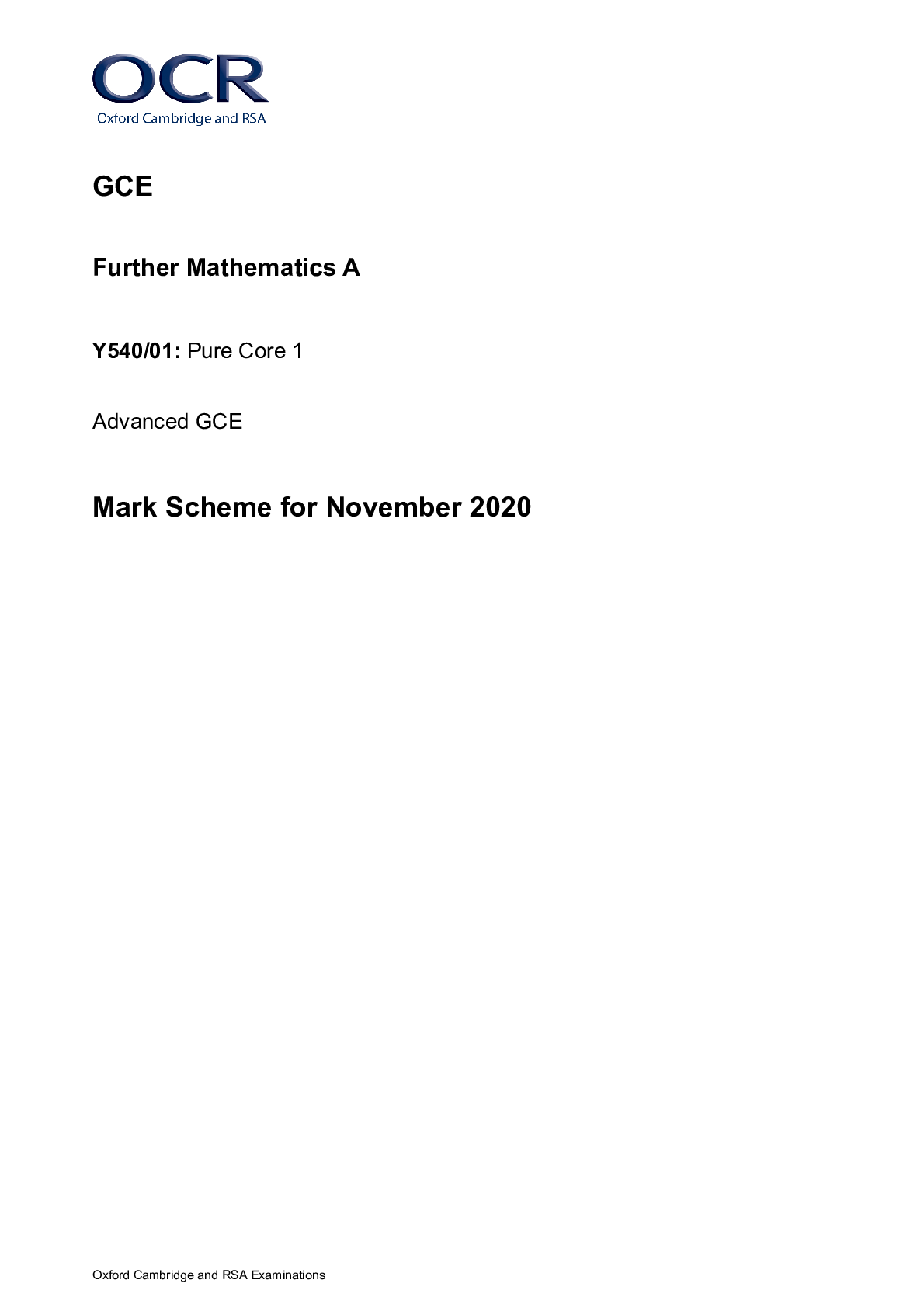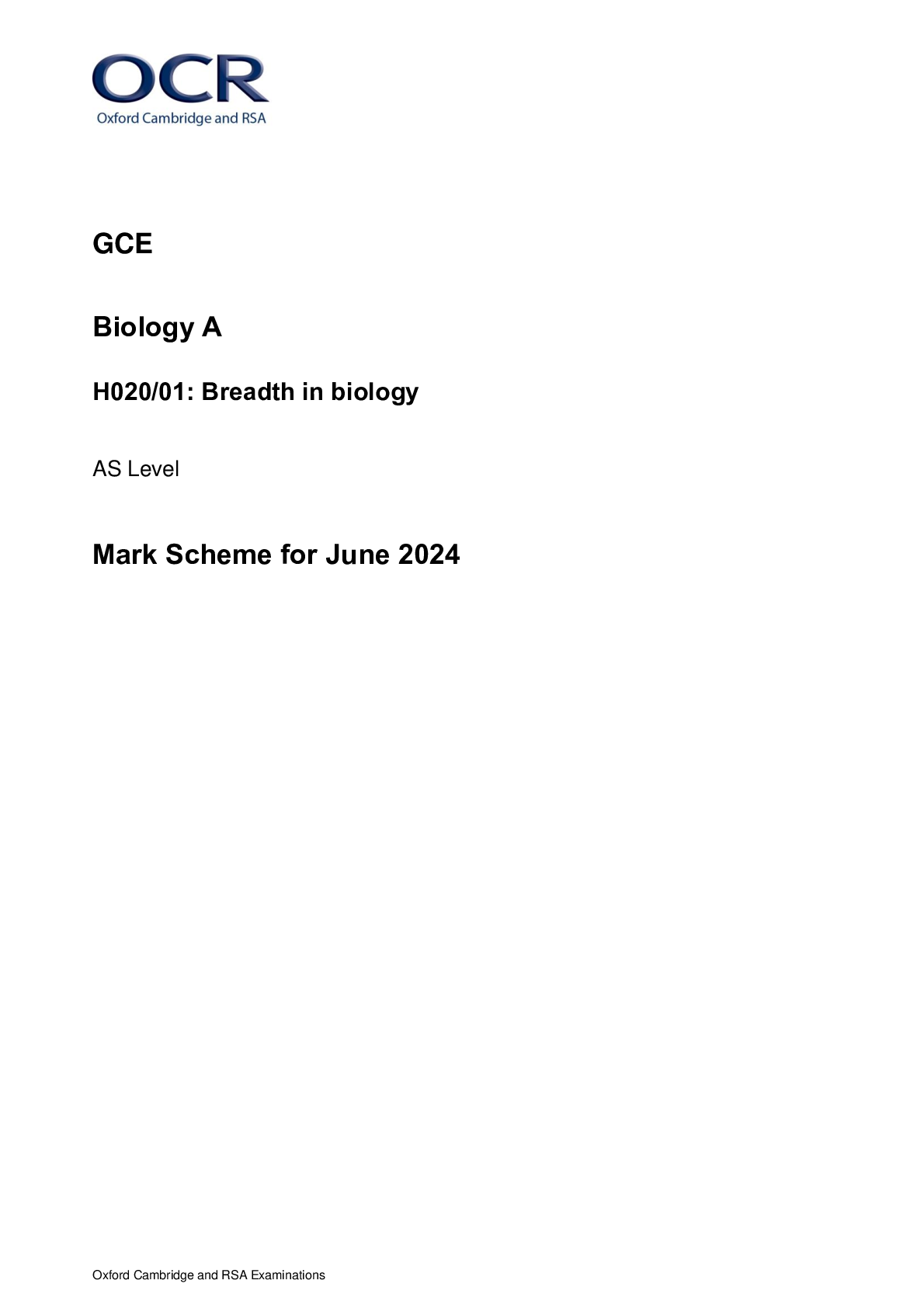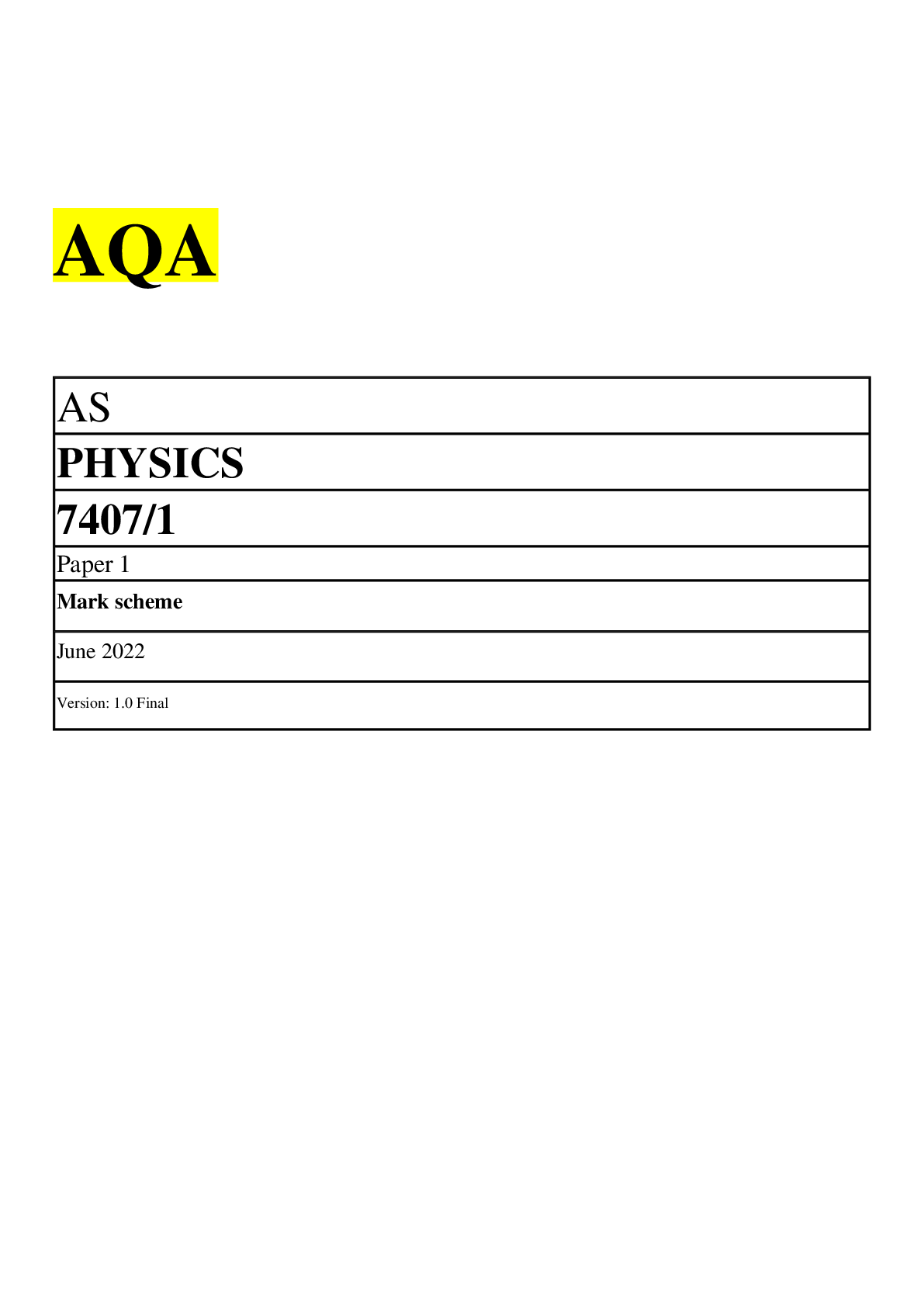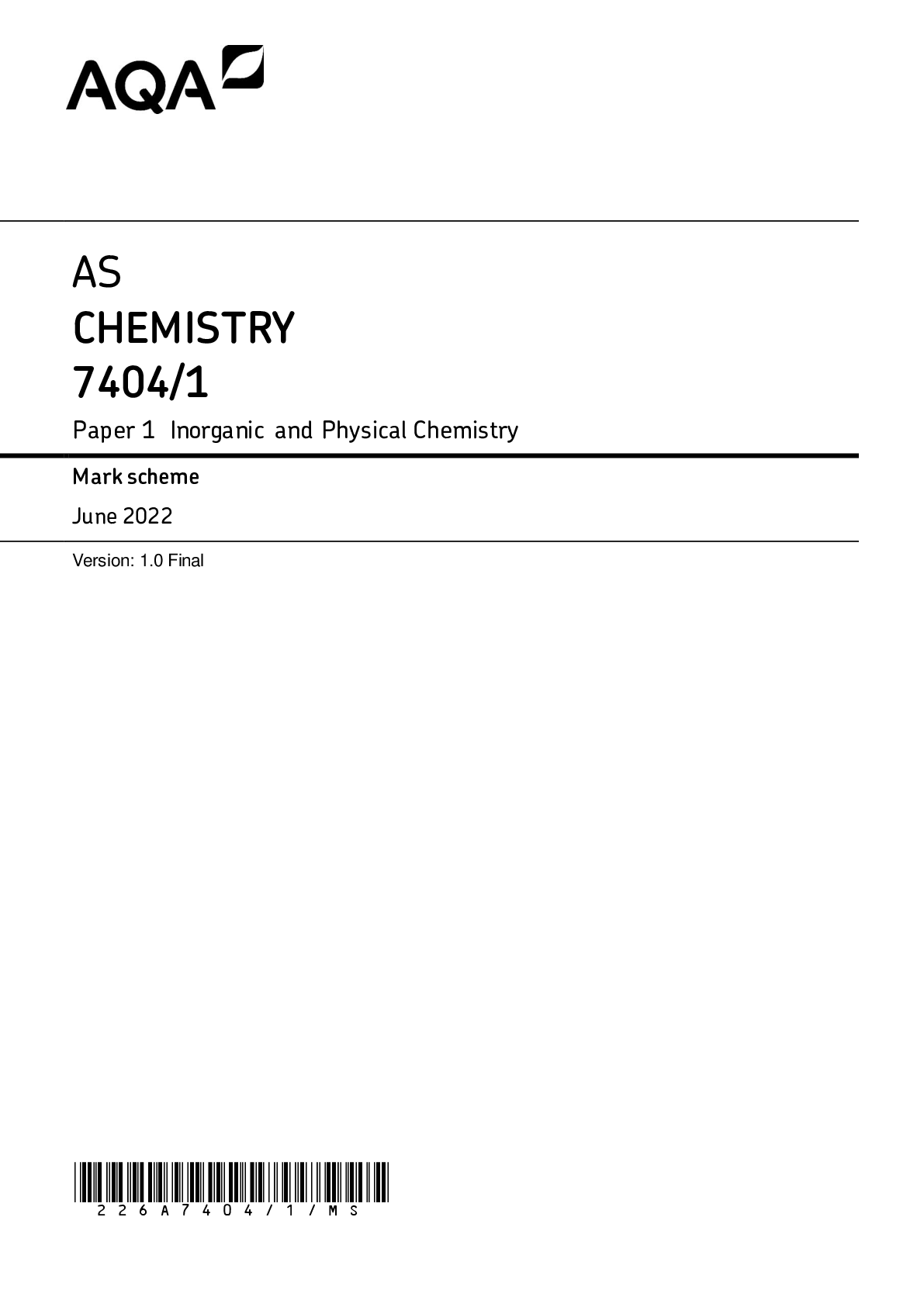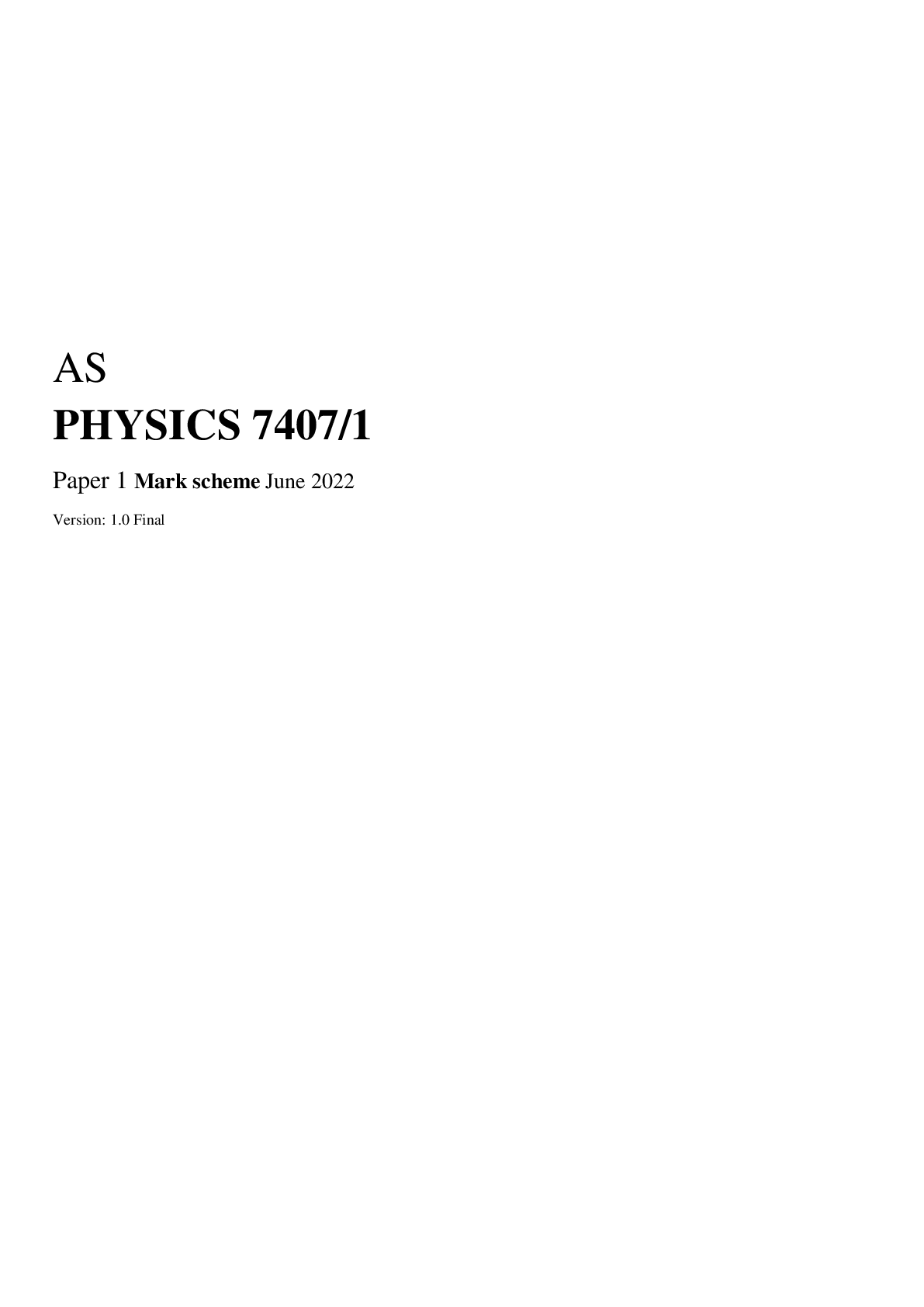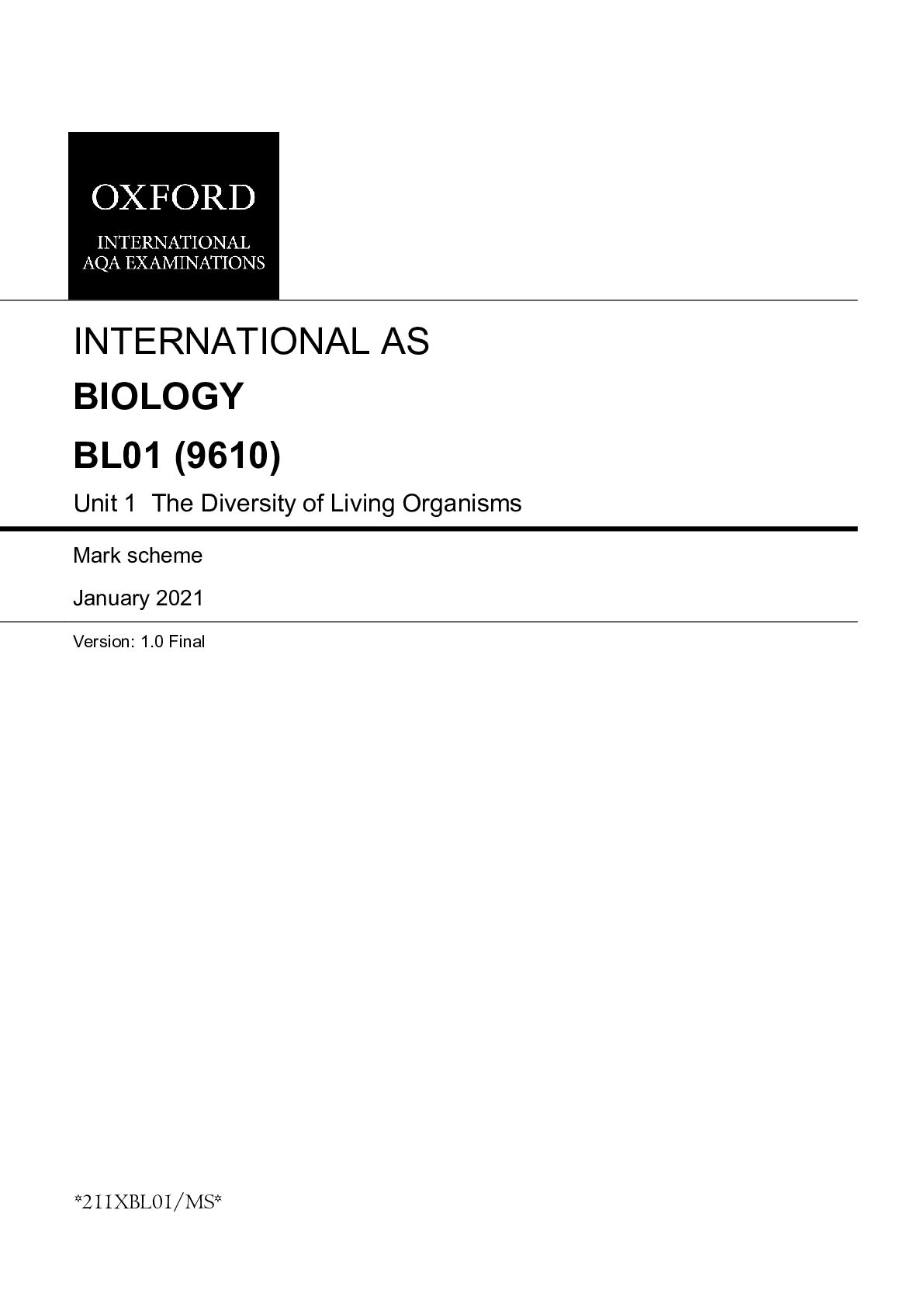Physics > AS Mark Scheme > GCE Physics A H156/01: Breadth in physics Advanced Subsidiary GCE Mark Scheme for November 2020 (All)
GCE Physics A H156/01: Breadth in physics Advanced Subsidiary GCE Mark Scheme for November 2020
Document Content and Description Below
GCE Physics A H156/01: Breadth in physics Advanced Subsidiary GCE Mark Scheme for November 2020 Oxford Cambridge and RSA Examinations GCE Physics A H156/01: Breadth in physics Advanced Subs ... idiary GCE Mark Scheme for November 2020Oxford Cambridge and RSA Examinations OCR (Oxford Cambridge and RSA) is a leading UK awarding body, providing a wide range of qualifications to meet the needs of candidates of all ages and abilities. OCR qualifications include AS/A Levels, Diplomas, GCSEs, Cambridge Nationals, Cambridge Technicals, Functional Skills, Key Skills, Entry Level qualifications, NVQs and vocational qualifications in areas such as IT, business, languages, teaching/training, administration and secretarial skills. It is also responsible for developing new specifications to meet national requirements and the needs of students and teachers. OCR is a not-for-profit organisation; any surplus made is invested back into the establishment to help towards the development of qualifications and support, which keep pace with the changing needs of today’s society. This mark scheme is published as an aid to teachers and students, to indicate the requirements of the examination. It shows the basis on which marks were awarded by examiners. It does not indicate the details of the discussions which took place at an examiners’ meeting before marking commenced. All examiners are instructed that alternative correct answers and unexpected approaches in candidates’ scripts must be given marks that fairly reflect the relevant knowledge and skills demonstrated. Mark schemes should be read in conjunction with the published question papers and the report on the examination. © OCR 2020H156/01 Final Mark Scheme November 2020 2 Here are the subject specific instructions for this question paper. CATEGORISATION OF MARKS The marking schemes categorise marks on the MACB scheme. M marks These are method marks upon which A-marks (accuracy marks) later depend. For an M-mark to be scored, the point to which it refers must be seen in the candidate’s answers. If a candidate fails to score a particular M-mark, then none of the dependent A-marks can be scored. A marks These are accuracy or answer marks, which either depend on an M-mark, or allow a C-mark to be scored. C marks These are compensatory method marks which can be scored even if the points to which they refer are not written down by the candidate, providing subsequent working gives evidence that they must have known it. For example, if an equation carries a C-mark and the candidate does not write down the actual equation but does correct working which shows the candidate knew the equation, then the C-mark is given. B marks These are awarded as independent marks, which do not depend on other marks. For a B-mark to be scored, the point to which it refers must be seen specifically in the candidate’s answers. SIGNIFICANT FIGURES If the data given in a question is to 2 sf, then allow an answer to 2 or more significant figures. If an answer is given to fewer than 2 sf, then penalise once only in the entire paper. Any exception to this rule will be mentioned in the Guidance.H156/01 Final Mark Scheme November 2020 3 Annotations Annotation Meaning Correct response Used to indicate the point at which a mark has been awarded (one tick per mark awarded). Incorrect response Used to indicate an incorrect answer or a point where a mark is lost. AE Arithmetic error Do not allow the mark where the error occurs. Then follow through the working/calculation giving full subsequent ECF if there are no further errors. BOD Benefit of doubt given Used to indicate a mark awarded where the candidate provides an answer that is not totally satisfactory, but the examiner feels that sufficient work has been done. BP Blank page Use BP on additional page(s) to show that there is no additional work provided by the candidates. CON Contradiction No mark can be awarded if the candidate contradicts himself or herself in the same response. ECF Error carried forward Used in numerical answers only, unless specified otherwise in the mark scheme. Answers to later sections of numerical questions may be awarded up to full credit provided they are consistent with earlier incorrect answers. Within a question, ECF can be given for AE, TE and POT errors but not for XP. L1 Level 1 L1 is used to show 2 marks awarded and L1^ is used to show 1 mark awarded. L2 Level 2 L2 is used to show 4 marks awarded and L2^ is used to show 3 marks awarded. L3 Level 3 L3 is used to show 6 marks awarded and L3^ is used to show 5 marks awarded. POT Power of 10 error This is usually linked to conversion of SI prefixes. Do not allow the mark where the error occurs. Then follow through the working/calculation giving ECF for subsequent marks if there are no further errors. SEEN Seen To indicate working/text has been seen by the examiner. SF Error in number of significant figures Where more SFs are given than is justified by the question, do not penalise. Fewer significant figures than necessary will be considered within the mark scheme. Penalised only once in the paper. TE Transcription error This error is when there is incorrect transcription of the correct data from the question, graphical read-off, formulae booklet or a previous answer. Do not allow the relevant mark and then follow through the working giving ECF for subsequent marks. XP Wrong physics or equation Used in numerical answers only, unless otherwise specified in the mark scheme. Use of an incorrect equation is wrong physics even if it happens to lead to the correct answer. ^ Omission Used to indicate where more is needed for a mark to be awarded (what is written is not wrong but not enough).H156/01 Final Mark Scheme November 2020 4 Abbreviations, annotations and conventions used in the detailed Mark Scheme (to include abbreviations and subject-specific conventions). Annotation Meaning / alternative and acceptable answers for the same marking point Reject Answers which are not worthy of credit Not Answers which are not worthy of credit Ignore Statements which are irrelevant Allow Answers that can be accepted ( ) Words which are not essential to gain credit ___ Underlined words must be present in answer to score a mark ECF Error carried forward AW Alternative wording ORA Or reverse argument SECTION AH156/01 Final Mark Scheme November 2020 5 Question Answer Marks Guidance 1 A 1 2 A 1 3 C 1 4 D 1 5 A 1 6 C 1 7 C 1 8 A 1 9 C 1 10 B 1 11 D 1 12 A 1 13 A 1 14 B 1 15 C 1 16 B 1 17 D 1 18 A 1 19 C 1 20 D 1 Total 20H156/01 Final Mark Scheme November 2020 6 SECTION B General rule: For substitution into an equation, allow any subject – unless stated otherwise in the guidance Question Answer Marks Guidance 21 (a) momentum kinetic energy / total energy B1 B1 Allow energy / mass (b) (Motion / speed / force / acceleration of person or skateboard is to the) left / opposite direction to ball / ‘backwards’ momentum is conserved / momentum of person = momentum of ball (but in opposite direction) (total) momentum is zero (at start or at the end or during the throwing of the ball) / speed of person < speed of ball B1 B1 B1 Allow ‘principle of conservation of momentum’ Allow ‘equal and opposite forces (acting on ball and person for the same time interval)’ Allow ‘different speed’ Allow velocity Total 5 Question Answer Marks Guidance 22 (a) v → m s-1 or v2 → m2 s-2 Clear algebra leading to base unit = kg m-1 M1 A1 (b) 0.12 1.20 (× 100) or 0.24 4.00 (× 100) or (k =) 2.78 (kg m-1) [2 × 0.1 + 0.06] or 0.26 or 26 % absolute uncertainty = 0.72 (kg m-1) C1 C1 A1 Allow (kmax =) 4.24 1.082 and (kmin =) 13.32 .762 or 3.635 and 2.158 Allow (range =) 1.48 Note: The answer must be given to 2 SF – as required by the question Ignore any value given for k on the answer line Total 5H156/01 Final Mark Scheme November 2020 7 Question Answer Marks Guidance 23 (a) (i) Straight line drawn from the bottom of the 9.0 m s-1 vector to the end of the 4.2 m s-1 vector B1 Ignore incorrect / omitted direction of resultant vector Ignore any other additional lines drawn (ii) v2 = 9.02 + 4.22 – 2 × 9.0 × 4.2 × cos50° v = 7.1 (m s-1) OR length of resultant vector line measured and some calculations v = 7.1 (m s-1) C1 A1 C1 A1 Allow other correct variants of this method Note answer to 3 SF is 7.07 Allow length of resultant vector in the range 5.4 – 5.6 cm Allow ± 0.20 (m s-1) (b) (i) (stress =) 7.5 8.2×10−7 or 9.15 × 106 (Pa) (strain =) 7.5 8.2×10−7 × 2.0×1011 or 4.57 × 10-5 x = 2.8 × 10-5 (m) OR � = �� �� 2.0 × 1011 = 7.5 × 0.62 8.2 × 10−7 × � x = 2.8 × 10-5 (m) C1 C1 A1 C1 C1 A1 Allow full credit for alternative methods Note answer is 2.84 × 10-5 to 3 SF Note answer is 2.84 × 10-5 to 3 SF Special case: 1 mark for 2.8 × 10-4 (m) or 2.9 × 10-6 (m); 7.5g or 7.5g-1 (g = 9.81) used instead of 7.5 (ii) acceleration at Y / deceleration at Z At Y (tension is) greater / (T ) > 7.5 (N) At Z (tension is) less / (T) < 7.5 (N) B1 B1 B1 Allow increasing velocity / increasing speed at Y Allow decreasing velocity / decreasing speed / negative acceleration at Z / slowing down Ignore ‘downward acceleration’ at Z Ignore drag throughout Allow (T) > weight Allow (T) < weight Total 9H156/01 Final Mark Scheme November 2020 8 Question Answer Marks Guidance 24 (a) (i) Systematic error / meter not zeroed (AW) B1 Allow resistance due to crocodile clips / resistance of connecting wires / internal resistance (of cell in ohmmeter) / resistance of ohmmeter (ii) Use a vernier calliper / micrometer to measure diameter of pencil lead (and hence determine A) ρ = gradient of line × A (Any subject) Any one from: • A = π�2 4 • Measure the diameter in several positions (and average) • Use a large ‘triangle’ to determine the gradient B1 B1 B1 Allow vernier / calliper Allow use of ‘slope’ for gradient Allow A = πr2 and d = 2r (b) (i) (1200 300 ) 4.0 B1 Allow 1 SF (ii) 180 = � ×25 6.7 × 10−8 ρ = 4.8 × 10-7 (Ω m) C1 A1 Note answer is 4.82 × 10-7 to 3 SF Total 7H156/01 Final Mark Scheme November 2020 9 Question Answer Marks Guidance 25 (a) Current less Cell has internal resistance or greater (total) resistance or p.d. across internal resistor or p.d. across resistor/10.0 (Ω) B1 B1 Allow ‘lost volts’ / power lost in cell Ignore wires have resistance (b) (VA =) 6.0 (V) or (RA =) 30 (Ω) For parallel lamps, any one from: (V|| =) 2.0 (V) or (I =) 0.10 (A) or (RL =) 20 (Ω) or (R|| =) 10 (Ω) resistance = 40 (Ω) C1 C1 A1 Not R|| = 15 (Ω); this is XP Total 5 Question Answer Marks Guidance 26 (a) constant phase (difference of 90°) B1 Ignore incorrect value Ignore same wavelength / frequency / period (b) (period =) 4.0 (ms) (f = 0.004-1) f = 250 (Hz) C1 A1 Allow 1 mark for 0.25; k omitted (c) (intensity =) �24 10�2(I0) intensity = 5.8 (I0) C1 A1 Not 144 25 �0 Allow 1 mark for 4.84; misread graph and used (22 10 )2 (d) resultant displacement = 10 (µm) B1 Allow ± 1.5; Ignore sign Total 6H156/01 Final Mark Scheme November 2020 10 Question Answer Marks Guidance 27 (a) (At the point where two or more waves meet the) resultant displacement is equal to the sum of the individual displacements (of the waves) B1 Allow sum / net / total for resultant Ignore vector sum Not amplitude (b) Maxima is when constructive (interference) occurs / phase difference is zero / path difference = nλ Minima is when destructive (interference) occurs / phase difference is 180(°) or π( rad) / path difference = (n + ½)λ at minima B1 B1 Allow ‘completely in phase’ for phase difference is zero Allow ‘antiphase’/ ‘completely out of phase’ for phase difference is 180(°) Allow 1 mark for ‘constructive and destructive (interference)’, without any link to the maxima and minima (c) (x =) 200 × 18 or (x =) 3600 (m) (λ =) 120 ×3600 2400 λ = 180 (m) C1 C1 A1 Not v = fλ ; 18 = 1 200 × � or λ = 3600 (m) Allow 3600 m from v = fλ when used as x here Note using x = 1800 m is XP (this gives 90 m) Total 6H156/01 Final Mark Scheme November 2020 11 Question Answer Marks Guidance 28 (a) Photon mentioned / one-to-one interaction (between electron and photon) (Maximum KE of electrons decreases as wavelength increases because) KE(max) = ℎ� � − � (Any subject) (When λ < λ0) energy (of photon) > work function / f > threshold frequency and electrons emitted / KE(max) ≠ 0 or (When λ = λ0) energy (of photon) = work function / f = threshold frequency and electrons just emitted / not emitted / KE(max) = 0 or (When λ > λ0) energy (of photon) < work function / f < threshold frequency and electrons not emitted / KE(max) = 0 B1 B1 B1 Not KE(max) = hf - φ by itself, but allow with c = fλ Allow ℎ� � or hf for ‘energy of photon’ and φ for ‘work function’ for this B1 mark Not f0 for threshold frequency Allow λ0 / threshold wavelength is the maximum wavelength for electrons to be emitted Allow threshold frequency is the minimum frequency for electron(s) to be emitted Allow work function is the minimum energy for electron(s) to be emitted (b) (i) E = 6.63 × 10−34 × 3.0 × 108 490 × 10−9 energy = 4.1 × 10-19 (J) C1 A1 Note answer to 3 SF is 4.06 × 10-19 (ii) (number of photons =) 0.230 4.06 × 10−19 number of photons = 5.7 × 1017 C1 A1 Possible ECF from (b)(i) Note answer is 5.6 × 1017 when 4.1 × 10-19 is used Total 7OCR (Oxford Cambridge and RSA Examinations) The Triangle Building Shaftesbury Road Cambridge CB2 8EA [Show More]
Last updated: 3 years ago
Preview 1 out of 13 pages

Buy this document to get the full access instantly
Instant Download Access after purchase
Buy NowInstant download
We Accept:

Reviews( 0 )
$7.50
Can't find what you want? Try our AI powered Search
Document information
Connected school, study & course
About the document
Uploaded On
Oct 07, 2022
Number of pages
13
Written in
All
Additional information
This document has been written for:
Uploaded
Oct 07, 2022
Downloads
0
Views
124











